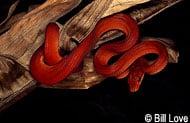Description:
This species is also referred to as the Garden Tree Boa, by experienced hobbyists as ATBs, and, in error, as Cook’s Tree Boa (a different species). Although hobbyists now breed many of the more desirable colors (red, orange, yellow and combinations of these colors), the majority of the less coveted colors (brown, tan, olive, gray, charcoal and combinations) are collected from the wild and imported. Brightly colored examples are usually considerably more expensive than those of duller color. Both captive bred and imported individuals are usually readily available in the pet trade. Amazon tree boas will bite readily and their long teeth render this an unpleasant experience. They are often best handled with a snake hook. Baby and imported tree boas may become dehydrated during transportation. Immediate rehydration is very important. When misted, freshly collected examples often drink beadlets of water from their bodies and nearby leaves more readily than from cage bottom drinking bowls. High cage humidity will help reduce dehydration but does not replace the need for the snakes to drink. Elevating the drinking bowl and roiling the water surface with an aquarium air stone (activated by a small vibrating pump) will often induce the snake to drink. Dehydration can result in regurgitation or refusal to eat. Imported snakes may also bear endoparasites. A stool sample should be analyzed by a veterinarian and if necessary purging should be carried out. Birds are an important prey item of wild specimens. Captives should be fed weekly and usually accept prekilled mice proffered on forceps. The mouse should not be larger in diameter than the width of the boas head. When hungry a tree boa will usually prowl actively in its cage or lie coiled with head and neck extended downward in a sinuous S striking-curve. Relatively high cage humidity should be provided these boas. Live plants can add beauty to a cage and also help elevate humidity. Baby Amazon tree boas can be maintained in a 5 to 10 gallon capacity terrarium. Adults should have a terrarium of at least a 20 gallon capacity and a 30 to 50 gallon size is probably better. A temperature gradient of 75 to 88 degrees Fahrenheit should be provided. Although they do not always climb, horizontal perches of about the same diameter as the snake’s body and climbing space should be provided. Amazon tree boas will usually choose a forked branch on which to coil. When the snakes are in elevated positions they usually anchor themselves with their prehensile tail.
Habitat:
Besides typical rainforest habitats, this highly arboreal taxon occurs also in dryer forests and in many grassland habitats. It is often seen in river- and oxbow-edge trees.
Range:
Predominantly a species of Amazonian South America east of the Andes to the Atlantic coast. They occur from Central Venezuela, eastern Colombia and the Guyana Shield countries in the north to central Bolivia and central Brazil in the south. In forested eastern Brazil the range extends far southward.
Scientific Name: Corallus hortulanus
Species Group: boa
Family: Boidae
Size: Often attains 4½ feet; occasionally attains 6½ to slightly more than 7 feet.
Level: intermediate
Weight: 1-to-3-lbs
Dangerous: No


